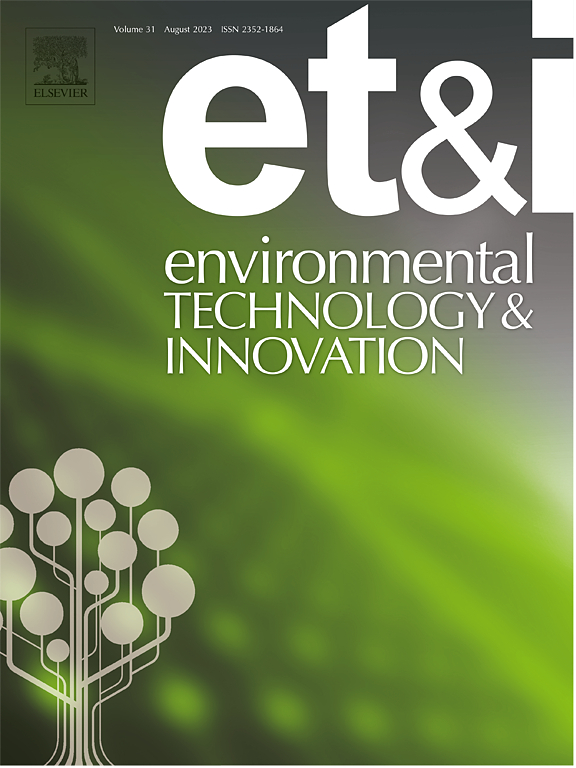Can the plastic-eating insect Alphitobius diaperinus be used as a new biodegradation agent for synthetic plastic insulator wastes?
IF 7.1
2区 环境科学与生态学
Q1 BIOTECHNOLOGY & APPLIED MICROBIOLOGY
引用次数: 0
Abstract
The long lifespan and inadequate waste management of plastics are responsible for a global environmental pollution and have significant consequences for ecosystems. Several insect species are avid plastivores, as for instance Tenebrionids which can biodegrade polystyrene and polyethylene. The lesser mealworm, Alphitobius diaperinus, is a pest of poultry farming facilities where it damages isolation panels. In this study, lesser mealworms were offered four different insulating plastic materials as food source and their effects on growth, energy stores and chemical biodegradation were studied. Both larvae and adults were observed consuming plastics, but with a clear preference for polystyrene and an absence of consumption for the dense polyisocyanurate material. Polystyrene consumption was 1.9 ± 0.77 mg per larva (over 30 days) and 5.5 ± 1.7 mg per adult (over 40 days). Plastic ingestion alone did not provide sufficient nutrients to the insect resulting in mortality, body mass loss, as well as reduced body reserves (glucose and triglycerides). We demonstrated partial biodegradation of polystyrene within larvae’ and adults’ gut, as indicated by chemical modifications observed in FTIR spectra and the degradation products identified through pyrolysis GC/MS analysis. In conclusion, A. diaperinus demonstrated the ability to consume and partially biodegrade plastics, particularly polystyrene. However, detrimental effects on survival, body weight, and energy reserves suggested that it is unlikely to be a viable solution for biodegrading plastic wastes if fed only with polystyrene. However, when provided with other nutrients such as cereals, it could potentially serve a beneficial role.
食塑昆虫双胞虫能否作为合成塑料绝缘体废弃物的新型生物降解剂?
塑料的使用寿命长和废物管理不足是造成全球环境污染的原因,并对生态系统产生重大影响。有几种昆虫是狂热的塑性动物,例如可以生物降解聚苯乙烯和聚乙烯的拟黄虫。较小的粉虫,是家禽养殖设施的害虫,它会破坏隔离板。以四种不同的绝缘塑料材料为食材,研究了其对粉虫生长、能量储存和化学生物降解的影响。观察到幼虫和成虫都食用塑料,但明显偏爱聚苯乙烯,而不食用致密的聚异氰脲酸酯材料。聚苯乙烯消费量为1.9 ± 0.77 mg /只幼虫(30天以上)和5.5 ± 1.7 mg /只成虫(40天以上)。单独摄入塑料并不能为昆虫提供足够的营养,导致死亡,体重减少,以及身体储备(葡萄糖和甘油三酯)减少。通过FTIR光谱观察到的化学修饰和热解GC/MS分析鉴定的降解产物,我们证实了聚苯乙烯在幼虫和成虫的肠道内的部分生物降解。综上所述,A. diaperinus显示出消耗和部分生物降解塑料的能力,特别是聚苯乙烯。然而,对生存、体重和能量储备的不利影响表明,如果只喂食聚苯乙烯,就不太可能成为生物降解塑料废物的可行解决方案。然而,当与谷物等其他营养素一起提供时,它可能会起到有益的作用。
本文章由计算机程序翻译,如有差异,请以英文原文为准。
求助全文
约1分钟内获得全文
求助全文
来源期刊

Environmental Technology & Innovation
Environmental Science-General Environmental Science
CiteScore
14.00
自引率
4.20%
发文量
435
审稿时长
74 days
期刊介绍:
Environmental Technology & Innovation adopts a challenge-oriented approach to solutions by integrating natural sciences to promote a sustainable future. The journal aims to foster the creation and development of innovative products, technologies, and ideas that enhance the environment, with impacts across soil, air, water, and food in rural and urban areas.
As a platform for disseminating scientific evidence for environmental protection and sustainable development, the journal emphasizes fundamental science, methodologies, tools, techniques, and policy considerations. It emphasizes the importance of science and technology in environmental benefits, including smarter, cleaner technologies for environmental protection, more efficient resource processing methods, and the evidence supporting their effectiveness.
 求助内容:
求助内容: 应助结果提醒方式:
应助结果提醒方式:


